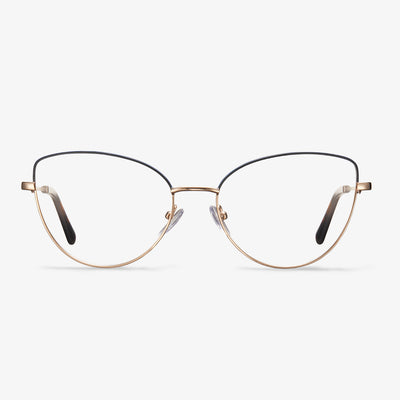Why Do My Glasses Give Me a Headache?
Why do my glasses give me a headache? There are a lot of reasons for new glasses headaches. So, in this section, we will list some of them.
Muscle strain: each eye contains six muscles. Since your eyes learn how to view the world through a new prescription, these muscles have to work harder do differently than they did before. So, this action may cause muscle strain within the eye and a headache. If you are wearing glasses for the first time or if your prescription has changed significantly, you may be prone to this effect.
Multiple lens power: if you have changed to a multiple lens power of glasses like bifocal glasses, varifocal glasses, it may be difficult to adapt in a short time. So, this change will lead to some problems such as headaches.
Poorly fitted frames: as for the issue of new glasses headaches, if you glasses fit too snugly across your nose or cause pressure behind your ears, you may get a headache. So, when purchasing a new pair of glasses, selecting a fitted one is important.
Wrong prescription: why do my glasses give me a headache? It can be caused by the wrong prescription. If your eyeglasses prescription is too weak or too strong, your eyes will become strained causing headaches. So, if you still suffer from headaches after wearing the new glasses for a few days, contact your eye doctor and check the prescription again.
FACTORY900
It has an avant-garde design and a very three-dimensional look. Many of its designs have gone beyond traditional eyewear. It has been producing plastic frames internally for 80 years. They have a history of pursuing technology, innovation in design, and special technology of plastic molding. And they are said to be available only to them in the world. They created a new type of EYEWEAR with the concept of THE FUTURES EYEWEAR. With the addition of planning and design to internal integrated production, it has been one of the few factory brands to perform almost all processes in the factory. Its unique shape and avant-garde design are highly valued not only in Japan but around the world.
What progressive spectacle lenses are best?
Essilor is a brand, and it designs, manufactures, and markets a wide range of lens products to help people correct and protect their vision. Essilor adheres to the corporate mission of 'improving vision, improving life', invests 200 million euros in research and development every year, and constantly launches new products to enhance consumers' experience in wearing glasses. Continuous innovation has always been the core gene of Essilor. In 1959, Essilor created the resin lens, and in the same year, it invented the world's first progressive lens. Innovation involves technology, manufacturing, sales, and service. Based on innovation, they can make as many people as possible obtain visual health, and this is the driving force to promote their development.
Choose rectangular glasses based on the shape of your face.
If you belong to the oval face, do not choose the too large or angular glasses frame. And do not choose long or square ones. It will be easy to elongate the face and affect the overall appearance. The shape of a round face is the opposite of a square face, so the buying principle of the glasses is basically the opposite of a square face. You need a more angular one to improve the shape of the face, but you need a square face (elongate) principle, that is, use a lower height, higher temple position of the frame.
Blue light in electronic products
In addition to the blue light that exists in natural light, LED energy-saving lamps, fluorescent lamps, computer monitors, mobile phones, and other digital products will emit blue light because of the use of light-emitting diode LED technology. Some people think that blue light hurts the eyes because blue light is not absorbed by the cornea and lens like ultraviolet light. The blue light can pass through the refractive medium of the eye to reach the retina, and then be absorbed by the pigment epithelium of the retina, which will cause aging and functional degradation of the retina over time.
The eyes also have many protection mechanisms, such as squinting, pupil contraction, lutein contained in the macula of the retina, and the retina's own antioxidant repair mechanism, which protect our eyes from blue light damage. And after scientific testing, it is found that the blue light emitted by electronic products is only several hundredths of the intensity of blue light in natural light. This means that as long as the electronic products are not used continuously every day (for example, more than 8-10 hours a day), the blue light will not cause obvious damage to the eyes.
Can clear lenses be polarized?
At present, there are no clear polarized lenses. A polarized lens is a thin film vertically arranged with silicon crystal coating placed inside the lens, just like a shutter, which covers the parallel light and only allows the vertical light to pass through. In this way, the glare from all directions can be eliminated, so it is clear and comfortable to wear. Transparent polyamide, the material of nylon lens, is a new variety of polyamide. The material of the nylon lens is mainly transparent polyamide. Due to the effect of the light filter, only light from a specific direction is allowed to pass through the lens, which filters the dazzling light from the sun on the water, land, or snow very well. It can not only make the landscape soft, clear, and natural but protect the eyes to a certain extent.
Select qualified optical lenses.
Anti-blue light lens must be qualified optical lens first and must have a certain percentage of anti-blue light effect. The general anti-blue light optical lens effect is about 30%. Even if it is not nearsighted people, it is best to choose the brand lens of reliable optical lens production enterprises. Anti-blue light lens is only suitable for people who use electronic display devices such as computers for a long time and is not suitable for patients with visual fatigue symptoms.











































